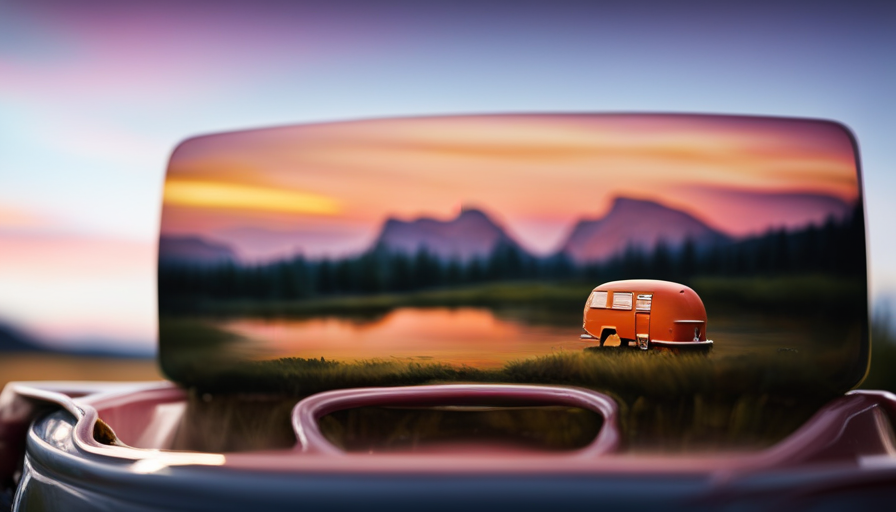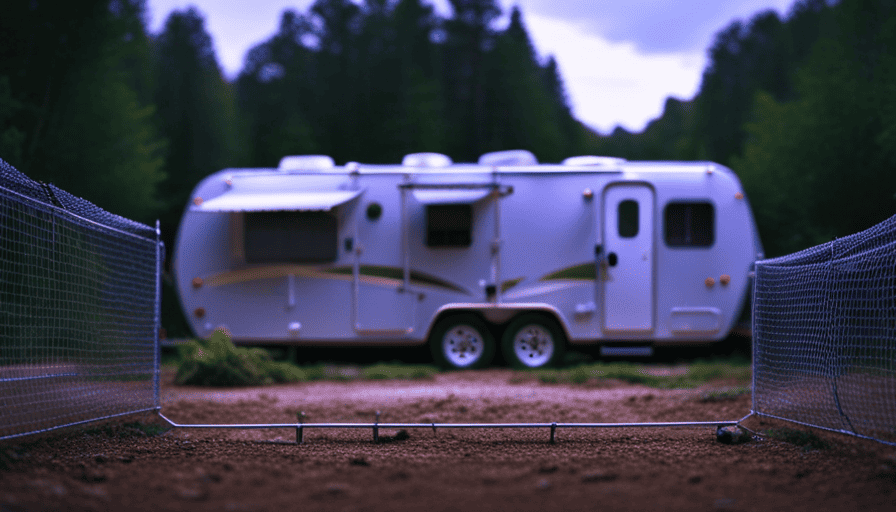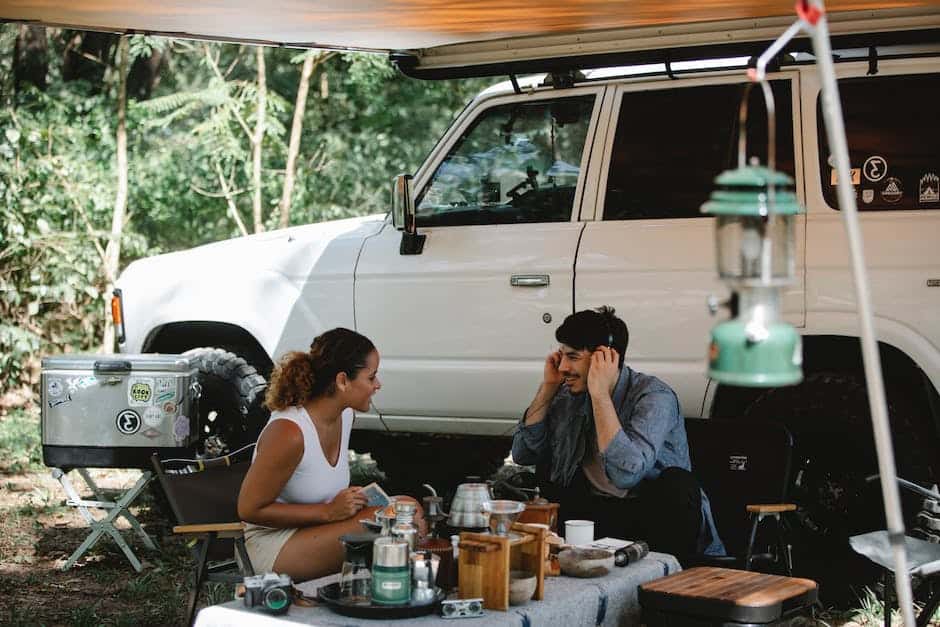Do you ever dream of giving your fiberglass camper shell a new, colorful appearance? Prepare to channel your artistic side because I’m going to teach you how to paint a fiberglass camper shell like a professional!
Picture this: your camper shell transformed into a canvas, waiting for you to bring it to life with color and creativity. In this step-by-step guide, I will walk you through the entire process, from gathering the necessary materials and preparing the surface, to choosing the perfect paint and applying it flawlessly.
With my precise instructions and detailed tips, you will achieve professional-looking results that will make heads turn on the road. So, grab your paintbrush and let’s dive into this exhilarating journey of turning your fiberglass camper shell into a masterpiece!
Key Takeaways
- Gather necessary materials and tools
- Prepare the surface properly with sanding and cleaning
- Choose a primer and paint specifically designed for fiberglass
- Allow sufficient drying time between coats and handle with care during the drying process
Gather the Necessary Materials and Tools
Before you start, make sure you’ve got all the materials and tools you’ll need to give your fiberglass camper shell a flawless paint job. First and foremost, choose the right paintbrush. Opt for a high-quality brush with synthetic bristles that are designed for use with fiberglass. This will ensure smooth and even application of the paint.
Additionally, it’s important to properly cover the surrounding areas to prevent any accidental spills or overspray. Use a drop cloth or plastic sheeting to protect the ground and any nearby objects from paint splatters.
In terms of tools, you’ll need sandpaper or a sanding block to prepare the surface of the camper shell for painting. Start by gently sanding the entire surface to remove any rough areas or imperfections. This will create a smooth base for the paint to adhere to. Don’t forget to wear a dust mask to protect yourself from inhaling any particles.
Once you have gathered all the necessary materials and tools, it’s time to move on to the next step of the process: preparing the surface of the camper shell.
Prepare the Surface of the Camper Shell
Start by thoroughly cleaning and sanding the smooth exterior of your mobile adventure companion, ensuring a fresh canvas for your creative touch. Surface preparation is crucial for achieving a professional-looking paint job on your fiberglass camper shell. To begin, gather the necessary materials and tools, including a bucket of warm soapy water, a scrub brush, and sandpaper with varying grits (such as 80, 120, and 220).
First, clean the camper shell using the warm soapy water and scrub brush. Remove any dirt, grime, or grease that may prevent the paint from adhering properly. Rinse the shell thoroughly and allow it to dry completely before moving on to the next step.
Next, begin sanding the surface of the camper shell. Start with the coarsest grit sandpaper (80) and gradually work your way up to the finest grit (220). This will help to remove any imperfections, smooth out any rough areas, and create a rough surface for the paint to adhere to. Be sure to sand in a circular motion, applying even pressure to avoid creating uneven spots.
Once the entire surface has been sanded, wipe it down with a clean cloth to remove any dust or debris. This will ensure a clean surface for applying the primer.
In the subsequent section, we will discuss how to prime the camper shell, which is the next step in the painting process.
Prime the Camper Shell
Get ready to give your mobile adventure companion the perfect base for a flawless paint job by applying a primer to the surface. Choosing the right primer is crucial for achieving a durable and long-lasting finish.
Look for a primer specifically designed for fiberglass surfaces, as it’ll adhere properly and provide excellent coverage. Before applying the primer, it’s important to properly sand the surface to ensure good adhesion. Start by using a fine-grit sandpaper to lightly sand the entire camper shell, removing any rough spots or imperfections.
Be sure to clean the surface thoroughly afterward to remove any dust or debris.
Once the surface is sanded and clean, it’s time to apply the primer. Use a paintbrush or a paint sprayer to apply the primer evenly to the entire surface of the camper shell. Pay extra attention to any areas that may have been repaired or patched, as these areas may require additional coats of primer for proper coverage. Allow the primer to dry completely according to the manufacturer’s instructions.
With the surface properly primed, you’re now ready to choose the right paint for your camper shell. The primer creates a smooth and uniform surface that’ll help the paint adhere better and provide a more professional-looking finish.
Choose the Right Paint
When choosing the right paint for a fiberglass camper shell, it’s important to consider the type of paint that will work best for your specific needs. Options include acrylic enamel, urethane, and epoxy paint, each with their own advantages and disadvantages.
Additionally, selecting the desired color or finish is crucial in achieving the desired aesthetic for your camper shell. Taking into account factors such as durability, weather resistance, and personal preference will help guide your decision-making process.
Consider the Type of Paint
First, make sure you’ve thoroughly researched and selected the appropriate type of paint for your fiberglass camper shell in order to achieve a professional and long-lasting finish.
When considering the type of paint, there are a few key factors to keep in mind.
-
Consider the cost: Different types of paint come with varying price tags. It’s essential to consider your budget and choose a paint that fits within your means.
-
Think about durability: The durability of the paint is crucial, especially for a camper shell that will be exposed to various weather conditions and potential wear and tear. Look for paints with high resistance to fading, cracking, and peeling.
-
Evaluate compatibility: Ensure that the paint you choose is compatible with fiberglass surfaces. Some paints may require specific primers or additives to adhere properly.
Once you have considered these factors, you can confidently move on to selecting the desired color or finish for your fiberglass camper shell.
Select the Desired Color or Finish
After considering the type of paint suitable for a fiberglass camper shell, it’s time to move on to the next step: selecting the desired color or finish.
When choosing the right paint color, it’s important to take into account personal preferences, the desired aesthetic, and the overall style of the camper. Additionally, considering different finish options is crucial to achieve the desired look and protect the paint.
Popular finish options include matte, gloss, satin, and metallic. Each option provides a unique appearance and durability level, so it’s important to choose the one that best suits your needs.
Once the color and finish have been selected, it’s time to move on to applying the paint, which will be discussed in the subsequent section.
Apply the Paint
To start applying the paint, make sure you have all the necessary supplies ready.
Here are some proper paint application techniques and tips for achieving a smooth and even finish:
-
Begin by thoroughly cleaning the surface of the fiberglass camper shell to remove any dirt, grease, or wax. Use a mild detergent and water, and rinse it well.
-
Next, lightly sand the surface using fine-grit sandpaper. This will create a rough texture for better paint adhesion.
-
Before applying the paint, apply a primer specifically designed for fiberglass surfaces. This will help the paint adhere better and provide a more durable finish.
-
Use a high-quality paint sprayer or a paintbrush to apply the paint. Start from the top and work your way down in even, overlapping strokes, ensuring complete coverage.
Allow sufficient drying time for the paint to fully cure and harden. This step is crucial to avoid any damage or imperfections in the finish.
Once the paint is dry, you can move on to the next stage of the process.
Allow Sufficient Drying Time
Be patient and give the paint some time to dry completely for a flawless and long-lasting finish. The importance of patience in allowing sufficient drying time can’t be overstated when it comes to painting a fiberglass camper shell. Rushing the process can lead to a myriad of issues, such as uneven texture, peeling, or paint damage.
To avoid these common mistakes, it’s crucial to follow the manufacturer’s instructions regarding the recommended drying time. Factors such as temperature and humidity can also affect the drying process, so it’s essential to consider these variables as well.
During the drying period, it’s essential to avoid any contact or disturbance to the painted surface. Even a slight touch can leave marks or indentations on the fresh paint. Additionally, keep in mind that dust or debris can easily adhere to the wet surface, resulting in imperfections. It’s advisable to cover the camper shell or work in a clean, controlled environment to minimize these risks.
Once the paint has fully dried, you can proceed to the next step of applying a clear coat for added protection. This protective layer won’t only enhance the durability of the paint but also provide a glossy finish.
Apply a Clear Coat for Protection
Adding a clear coat ensures a longer lifespan and a sleek, glossy appearance to your fiberglass camper shell. To achieve a glossy finish, there are a few tips to keep in mind.
First, make sure the surface is clean and free from any debris or contaminants. This will ensure that the clear coat adheres properly and creates a smooth finish.
Next, apply the clear coat in thin, even layers using a high-quality paint sprayer. This will prevent any drips or unevenness in the final result. Allow each layer to dry completely before applying the next one. It’s important to follow the manufacturer’s instructions regarding drying time.
Common mistakes to avoid include applying the clear coat too thickly, which can lead to runs and a less smooth finish. Additionally, rushing the drying process can result in a tacky or uneven surface.
Taking the time to properly apply and dry the clear coat will ensure a professional-looking, glossy finish.
In the next section, we’ll discuss how to reinstall the camper shell seamlessly.
Reinstall the Camper Shell
Gently secure your mobile adventure capsule back onto its rightful place for a seamless and effortless reintegration. To ensure the camper shell is properly reinforced, it is crucial to follow the correct installation process. Begin by aligning the shell with the truck bed, making sure it fits snugly. Utilize the mounting hardware provided, such as bolts and clamps, to firmly attach the camper shell to the truck bed. This will prevent any potential movement during transportation.
In addition to the basic installation, you may want to consider adding additional accessories to enhance the functionality and aesthetics of your camper shell. These accessories could include roof racks for extra storage, side windows for improved ventilation, or even a rear ladder for easy access to the roof. Consult the manufacturer’s instructions for each accessory to ensure proper installation and compatibility with your specific camper shell model.
By reinforcing the camper shell structure and adding these additional accessories, you can customize your mobile adventure capsule to suit your needs and preferences. Once the camper shell is securely installed, it is time to clean up and dispose of any materials properly. [Transition sentence: As we wrap up the installation process, let’s now focus on the crucial step of clean up and disposing of materials properly.]
Clean Up and Dispose of Materials Properly
Now it’s time to tidy up and properly dispose of any leftover debris from the installation process. It’s important to follow proper disposal methods to minimize the environmental impact.
Start by gathering all the tools, such as brushes, rollers, and containers, and clean them thoroughly. Rinse the brushes with water and mild soap to remove any paint residue. Dispose of the rinse water properly, avoiding any drainage systems or natural water sources.
Empty the containers in a designated hazardous waste disposal facility, as they may contain harmful chemicals.
Next, collect any leftover paint cans, solvents, and other materials used during the painting process. Check local regulations to determine the appropriate disposal method for these items. Some cities have special collection events or facilities for hazardous waste disposal. Be sure to seal the containers tightly to prevent any leaks or spills.
Once the cleanup is complete, take a moment to appreciate your hard work and enjoy your newly painted fiberglass camper shell! It’s time to hit the road and show off your stylish and personalized camper shell.
Enjoy Your Newly Painted Fiberglass Camper Shell!
Once the cleanup is done, you can finally bask in the satisfaction of your transformed mobile oasis and embark on unforgettable adventures. To ensure that your newly painted fiberglass camper shell stays in pristine condition, there are a few tips for maintaining it. Firstly, regularly wash the surface with a mild soap and water solution to remove any dirt or grime that may accumulate over time. Avoid using abrasive cleaners or scrub brushes that can cause scratches. Secondly, apply a protective wax or sealant to the painted surface to provide an extra layer of defense against UV rays and environmental elements. This will help to prevent fading and maintain the shine of your camper shell. Lastly, be cautious of common mistakes to avoid when painting a fiberglass camper shell. These include rushing the preparation and painting process, not using the appropriate primer or paint for fiberglass, and not allowing enough drying time between coats. By following these maintenance tips and avoiding common mistakes, you can enjoy your beautifully painted fiberglass camper shell for years to come.
| Tips for maintaining a painted fiberglass camper shell | Common mistakes to avoid when painting a fiberglass camper shell |
|---|---|
| Regularly wash the surface with mild soap and water | Rushing the preparation and painting process |
| Apply a protective wax or sealant | Not using the appropriate primer or paint for fiberglass |
| Be cautious of common mistakes | Not allowing enough drying time between coats |
Frequently Asked Questions
How do I properly clean and prepare the surface of the camper shell before painting?
To properly prepare the surface of a fiberglass camper shell before painting, I employ meticulous cleaning techniques. Firstly, I thoroughly clean the surface using a mild detergent and water solution to remove any dirt, grease, or grime.
Next, I carefully inspect the surface for any imperfections or rough areas, which I address by sanding them down using fine-grit sandpaper.
Finally, I wipe the entire surface with a clean cloth soaked in rubbing alcohol to remove any remaining residue and ensure a smooth and clean surface for painting.
Can I use any type of primer or is there a specific type I should use for fiberglass?
When it comes to priming fiberglass, it’s crucial to choose the right type of primer. Using just any primer won’t cut it. Trust me, it’s like trying to put a square peg in a round hole.
You need a primer specifically designed for fiberglass. These primers have special additives that enhance adhesion and durability. Properly preparing the surface is equally important. It ensures the paint adheres properly and provides a long-lasting finish.
What are the best types of paint to use on a fiberglass camper shell?
The best paint brands for a fiberglass camper shell are ones specifically formulated for use on fiberglass surfaces. Brands like Rust-Oleum, Krylon, and Dupli-Color offer excellent options.
To achieve a smooth finish, start by sanding the surface with fine-grit sandpaper to remove any imperfections. Then, apply a high-quality primer designed for fiberglass.
After allowing the primer to dry, use a spray gun or brush to evenly apply multiple coats of the chosen paint, following the manufacturer’s instructions for drying times between coats.
How long should I wait for the paint to dry before applying a clear coat?
When it comes to applying a clear coat to your freshly painted fiberglass camper shell, it’s crucial to allow ample drying time. The waiting period before applying the clear coat is essential for achieving a flawless finish.
Generally, you should wait at least 24 hours for the paint to dry completely before proceeding with the clear coat. This ensures that the paint has cured properly and won’t be compromised when the clear coat is applied.
Patience is key to achieving professional results.
Are there any special maintenance or cleaning instructions for a newly painted fiberglass camper shell?
There are some special cleaning instructions and maintenance tips to keep in mind for a newly painted fiberglass camper shell.
To begin with, it’s important to avoid using abrasive cleaners or harsh chemicals, as they can damage the paint. Instead, opt for mild soap and water to clean the surface.
Additionally, regular waxing can help protect the paint and maintain its shine.
Lastly, be sure to inspect the shell regularly for any signs of damage or wear, and address them promptly to prevent further issues.
Is the Process of Painting a Fiberglass Camper Shell Different from Painting a Regular Camper Shell?
The process of painting a fiberglass camper shell differs slightly from painting a regular camper shell. Fiberglass camper shells require specialized products and techniques to ensure proper adhesion and longevity of the paint finish. Surface preparation, including sanding and primer application, is crucial for painting a camper shell made of fiberglass to achieve a smooth and durable result.
Conclusion
In conclusion, painting a fiberglass camper shell is a labor of love, much like taming a wild stallion. It requires patience, skill, and the right tools to transform a worn-out shell into a thing of beauty.
Just as a skilled rider can train a wild horse, with the right techniques and materials, you can bring new life to your camper shell. So saddle up, grab your paintbrush, and embark on this journey of transformation. Your camper shell will thank you, and you’ll be rewarded with a stunning masterpiece on wheels.
Happy painting!










